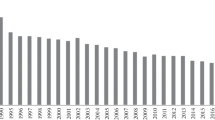Abstract
The general concepts of the arrangement of water body monitoring are considered, which assume more effective use of the available data and observation systems and the implementation of additional studies and managerial activities aimed to take into account the formation factors of natural water quality under the effect of diffuse pollution sources.




Similar content being viewed by others
REFERENCES
GOST (State Standard) 17.1.3.07-82: Nature Protection. Hydrosphere. Regulations for Water Quality Control in Water Bodies and Streams, 1986.
Kirpichnikova, N.V., Studying uncontrolled pollution sources: case study of the Ivankovo Reservoir, Extended Abstract of Cand. Sci. (Eng.) Dissertation, Moscow: Water Problems Institute, 1991.
Kirpichnikova, N.V. and Polyanin, V.O., Organization of monitoring diffuse pollution of natural water, Nauchnye problemy ozdorovleniya Rossiiskikh rek i puti ikh resheniya (Scientific Problems of Improvement of Russian Rivers and Ways of Their Solution. Coll. Sci. Pap.), Moscow: Studiya F1, 2019, pp. 389–395.
Motovilov, Yu.G. and Fashchevskaya, T.B., Spatially distributed model of heavy metal runoff formation in a river basin, VODA: Khim. Ekol., 2018, nos. 1–3, pp. 18–31.
Postanovlenie Pravitel’stva RF “Ob utverzhdenii polozheniya ob osushchestvlenii gosudarstvennogo monitoringa vodnykh ob’’ektov” ot 10.04.2007 № 219 (c izmeneniyami ot 22 aprelya, 7 oktyabrya 2009 g.) (RF Government Decree “On the Approval of Regulations on the Implementation of State Monitoring of Water Bodies” of April 10, 2007, no. 219 (with amendments of April 22, October 7, 2009)).
Postanovlenie Pravitel’stva RF “Ob utverzhdenii polozheniya o gosudarstvennom monitoringe sostoyaniya i zagryazneniya okruzhayushchei sredy” (06.06.2013 g. № 477) (RF Governmental Decree “On the Approval of Regulations on the State Monitoring of the Environmental State and Pollution” (June 6, 2013, no. 477)).
Postanovlenie Pravitel’stva RF “Ob utverzhdenii polozheniya o gosudarstvennom ekologicheskom monitoringe (gosudarstvennom monitoringe okruzhayushchei sredy) i gosudarstvennom fonde dannykh gosudarstvennogo ekologicheskogo monitoringa (gosudarstvennogo monitoringa okruzhayushchei sredy)” (09.08.2013 g. № 681) (RF Governmental Decree “On the Approval of Regulations on the State Ecological Monitoring (State Environmental Monitoring and the State Data Fund on State Ecological Monitoring (State Environmental Monitoring) (August 9, 2013, no. 681))).
RD 52.24.309-2016. Rukovodyashchii dokument. Organizatsiya i provedenie rezhimnykh nablyudenii za sostoyaniem zagryazneniem poverkhnostnykh vod sushi (Guideline Document. Organization and Implementation of Regular Observations of the State and Pollution of Continental Surface Water).
Strategicheskoe rukovodstvo po monitoringu i otsenke transgranichnykh rek, ozer i podzemnykh vod (EEK OON ECE/MP.WAT/20), razrabotannoe rabochei gruppoi po monitoringu i otsenke (WGMA) na osnove obobshcheniya desyatiletnego opyta realizatsii Konventsii EEK OON po okhrane i ispol’zovaniyu transgranichnykh vodotokov i mezhdunarodnykh ozer (Rossiya—storona Konventsii) (Strategic Guide for Monitoring and Assessing Transboundary Rivers, Lakes, and Groundwaters (EEK OON ECE/MP.WAT/20), Developed by the Working Group for Monitoring and Assessing (WGMA) by Generalizing Decadal Experience in the Implementation of EEC UN Convention on the Protection and Use of Transboundary Streams and International Lakes (Russia is a party of the Convention)).
Dressing, S.A., Meals, D.W., Harcum, J.B., Spooner, J., Stribling, J.B., Richards, R.P., Millard, C.J., Lanberg, S.A., and O’Donnell, J.G., www.epa.gov/ polluted-runoff-nonpoint-source-pollution/monitoring-and-evaluating-nonpoint-source-watershed. Accessed: January 20, 2020.
National Nonpoint Source Monitoring Program. [Electronic Resource] www.epa.gov/nps/national-nonpoint-source-monitoring-program. Accessed January 20, 2020.
Novotny, V. and Chesters, G., Handbook of Non-Point Pollution, N.Y.: Van Nostrand Reinhold Co., 1981.
ACKNOWLEDGMENTS
The author is grateful to S.D. Belyaev (Russian Research Institute for Integrated Use and Protection of Water Resources) for presented materials and consultations.
Funding
This study was carried out under Governmental Order to Water Problems Institute (Subject 0126-2019-0038, State Registration AAAA-A18-118061800142-8).
Author information
Authors and Affiliations
Corresponding author
Additional information
Translated by G. Krichevets
Rights and permissions
About this article
Cite this article
Polyanin, V.O. Conceptual Approaches to Monitoring Diffuse Pollution of Water Bodies. Water Resour 47, 785–793 (2020). https://doi.org/10.1134/S0097807820050152
Received:
Revised:
Accepted:
Published:
Issue Date:
DOI: https://doi.org/10.1134/S0097807820050152




